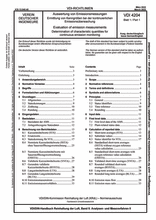Standards Worldwide
Standards Worldwide
Phone +49 30 58885700-07

Technical rule [CURRENT]
VDI 4204 Blatt 1:2022-03
Evaluation of emission measurements - Determination of characteristic quantities for continuous emission monitoring
- German title
- Auswertung von Emissionsmessungen - Ermittlung von Kenngrößen bei der kontinuierlichen Emissionsüberwachung
- Publication date
- 2022-03
- Original language
- German, English
- Pages
- 39
- Publication date
- 2022-03
- Original language
- German, English
- Pages
- 39
Product information on this site:
Quick delivery via download or delivery service
Buy securely with a credit card or pay upon receipt of invoice
All transactions are encrypted
Short description
This standard specifies requirements for the determination of characteristic quantities for the evaluation of emission measurements with continuously recording automated measuring systems (AMS) and corresponding data acquisition and handling systems (DAHS). It deals with characteristic quantities of air pollutants within the scope of the Federal Immission Control Act (BImSchG) and characteristic quantities of greenhouse gases within the scope of the Greenhouse Gas Emissions Trading Act (TEHG). It supplements the requirements of DIN EN 17255-1 and DIN EN 17255-2 for the handling and reporting of data. This VDI Standard deals with the determination of the following characteristic quantities: standardised short-term averages; standardised short-term averages converted to oxygen reference value; validated short-term averages; rounded validated short-term averages; long-term averages; rounded long-term averages; short-term values of the emission mass flow; long-term values of the emission mass flow; emission mass ratio; annual mass emission of greenhouse gases; weighted annual average of greenhouse gas mass concentrations; annual value of the waste gas volume. This standard also deals with the comparison of characteristic quantities with limit values or other assessment standards. This standard is addressed to manufactures of DAHS for emission monitoring, to test institutes performing performance tests of DAHS, and to the authorities responsible for the declaration of suitability. Furthermore, it assists users of performance-tested DAHS for emission monitoring in the operation of these systems.
Content
ICS
13.040.40
Also available in
Loading recommended items...
Loading recommended items...
Loading recommended items...
Loading recommended items...
